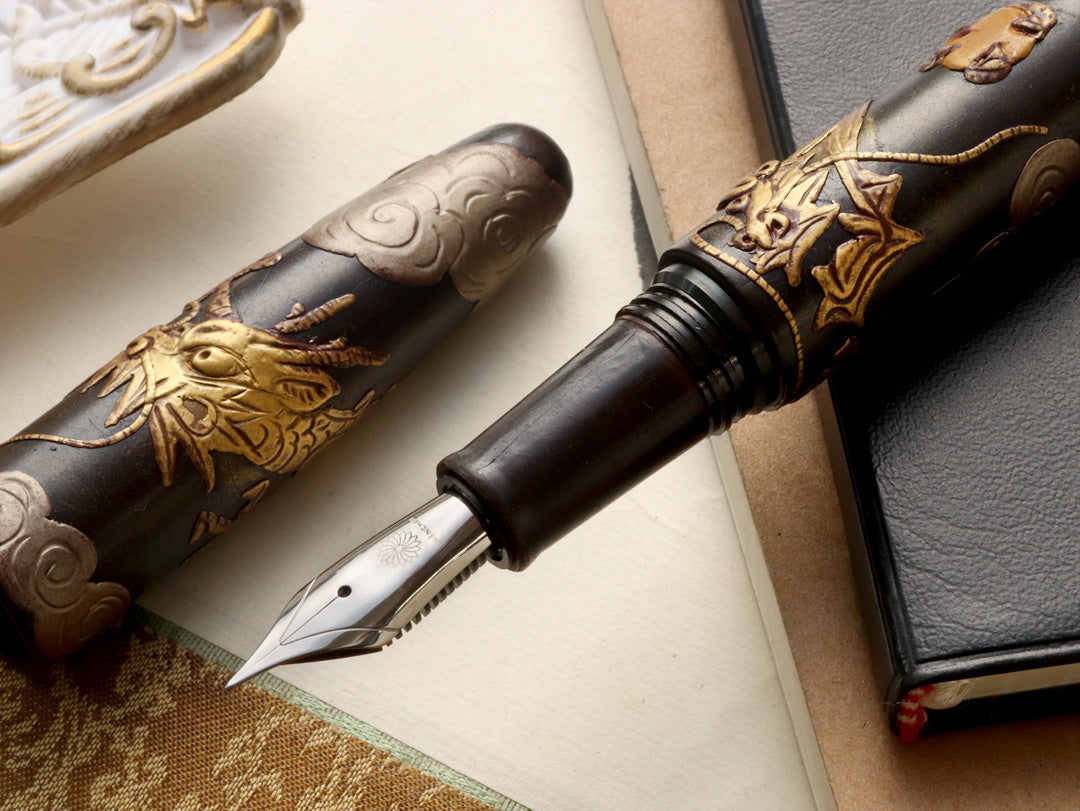Tsuikin - Twin Dragons - Black Sohari
Tsuikin - Twin Dragons - Black Sohari
Couldn't load pickup availability
Description
Description
Note:
- The Tsuikin art does not required any polishing step. Therefore, sometimes it might leave the surface with a few uneven dots. *Please do not mistake this with defects.*
- The hand-making process makes every single pen a unique one, there is no pen exactly resembling one another. The one you will receive might be slightly different from the one here in the pictures, yet this characteristic makes each pen a unique work of art, with no two pieces exactly the same.
The Ryukyu Tsukin Urushi
On May 15, 2022, Okinawa prefecture celebrates the 50th anniversary of its return to Japan. To commemorate this major milestone in Okinawan history, Wancher is thrilled to introduce you to another traditional-art-infused fountain pen - Dream Pen Ryukyu Tsuikin - The Twin Dragons!
A brief history of Okinawa
The Ryukyu Islands first appeared in the ancient Chinese history book entitled "Sui Shu” around 607. After almost one and a half decades of going through the Chinese tributary system, two dynasties, and the Satsuma invasion, Ryukyu Kingdom was demolished by Meiji Government in 1879, and Okinawa prefecture was born. Yet again, when the Pacific War ended in 1945, Okinawa was once again parted from Japan as the U.S limitary remained under their governance for the following 27 years. On May 15, 1972, Okinawa was officially returned to Japan, marking a new milestone in both Okinawa and Japan's history.
The origin of Ryukyu Tsuikin art
Despite the complicated history, the culture and traditional crafts, especially lacquering, fortunately, have flourished, preserved, and continued until today. Old documents record that Okinawan lacquerware appeared as soon as 1427, with a purchase record from Emperor Xuanzong of the Ming Dynasty. After the establishment of the First Ryukyu Dynasty (1429), the Kaizuri Bugyosho (a magistrate's office for lacquerware production) was founded.
In Okinawa, where politics and culture are deeply connected, lacquerware and lacquer ornaments were indispensable for ceremonies and rituals, not only for royalties and warrior families but also for local communities. Especially, after the invasion by the Satsuma Domain, the need of lacquerware increases as they need to tribute to both the Tokugawa shogunate and Chinese emperors. Therefore, the Ryukyu Kingdom put the Kaizuri Bugyosho under its direct control to strengthen lacquerware production.
During this period - the highest peak of Ryukyu lacquer, Ryukyu governors even sent craftsmen to China several times and brought in various lacquering techniques. One of those craftsmen - Higa Josho has developed the Okinawan-own technique - Tsuikin.
How Tsuikin art was made
“Tsuikin" involves many processes and requires a high level of skill. First, pigments are kneaded into lacquer to make "Tsuikin-mochi," which is shaped like a rice cake. Next, the Tsuikin-mochi is rolled out thinly on a board using a roller to cut out a pattern to be pasted on a vessel. In addition, fine lines are chiseled on the pasted pattern, which is then colored last. Highly adhesive, the finish can last for a long time.
There are three models we would like to present to you this time:
Tsuikin - Twin Dragons - Black Urushi
Tsuikin - Twin Dragons - Red Urushi
Tsuikin - Twin Dragons - Urushi So-hari (Base: Nashiji Tsuikin-mochi)
Wancher Tsuikin fountain pens came with the motif of Twin Dragons, which are made with Tsuikin-mochi mixed with real platinum and gold powder. The Twin Dragons are legendary auspicious creature in Okinawan mythology and folktales besides Shisa (another mythical symbol of Okinawan culture).
We hope that this symbol will deliver the cultural value of Okinawa as well as good luck to the fountain pens' owners. Holding this pen in your palms, we can feel the rich Okinawan history running through your veins and feel closer to the culture of Okinawa.
Specifications
Material & art: Ebonite, Tsuikin Urushi
Filling mechanism: Converter or Cartridge (European International Standard)
Nib: #6 Jowo stainless steel, Wancher 18K gold
Feed: Plastic, ebonite black, ebonite red
Compact air-tight cap: Prevent dried-out ink problem

Size & Shape

Packaging
Traditional Japanese Wooden Box + Pen Kimono + Instructional Materials + Certificate + Converter + Cartridge
Share

























